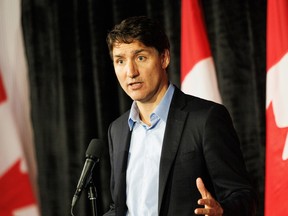In some of the country’s largest cities, employers won’t be able to hire for the low-wage stream. But in smaller centres the program will remain open
Article content
OTTAWA — Prime Minister Justin Trudeau announced reductions to the temporary foreign worker program Monday, but there are many exceptions to the clampdown that could still see thousands of people brought to Canada for short-term work.
Trudeau said the program needs to be reined in as the country’s unemployment rate rises.
“We no longer need as many temporary foreign workers. We need Canadian businesses to invest in training and technology and not increase their reliance on low-cost foreign labour,” he said at the start of a three-day cabinet retreat in Halifax.
Advertisement 2
Article content
The Liberals’ new rules will restrict some low-wage employers from using the program, but data reviewed by the National Post show nearly 27,000 high-wage jobs that won’t be restricted were recently approved.
At the end of the pandemic in 2022, the Liberals eased some of the restrictions on the program because at the time labour shortages were common. The Liberal government removed a rule that prevented workers from applying to bring in temporary foreign workers if local unemployment was higher than six per cent.
It also removed a rule about the percentage of a company’s workforce that could be temporary foreign workers and allowed temporary foreign workers to stay longer.
Beginning next month, those relaxed rules will change back; the six-per cent rule will go into force and workers will be limited to a one-year stay. It will also prevent businesses from using TFWs for more than 10 per cent of their workforce.
Trudeau said easing restrictions on the program made sense in 2022, but things have changed.
“That’s what the business community needed. That’s what the business community was asking for and at that moment in time, those changes helped. They helped the economy and they helped businesses make it through a challenging moment in our economic recovery.”
Article content
Advertisement 3
Article content
Recommended from Editorial
Trudeau said his government won’t be receptive to arguments about labour shortages now.
“To those who would complain about worker shortages, here’s my message: there is no better time to hire and invest in Canadian workers.”
The government is granting exemptions for jobs in food processing, agriculture, health care and construction.
Trudeau’s announcement on Monday changes the rules for the low-wage stream, one of five streams of temporary foreign workers. The other streams include agricultural workers brought to Canada to work and often live on farms, a seldom used permanent residence stream for employers who are helping workers come to Canada permanently and a Global Talent stream for people with unique skills.
In addition to the low-wage stream, which Trudeau is now restricting, there is a high-wage stream that is also bringing in thousands of workers. The dividing line between the two streams is the median wage in the province, ranging from $24 per hour in Nova Scotia to just over $39 per hour in the Northwest Territories.
Advertisement 4
Article content
The government posts data on temporary foreign worker applications every quarter, providing basic information on the companies that use the program and the number of workers they bring in. Employers need to fill out a labour market impact assessment, detailing the steps they took to try to find Canadian applicants.
The National Post reviewed the last six months of available data between October 2023 and March of this year. During that time, just over 26,000 employers applied to bring in nearly 50,000 low-wage workers.
The list includes Toronto’s Albany Club, which bills itself as the “premier private club for leaders in Canada’s business and Conservative political spheres.” It also includes a variety of Tim Horton’s franchises including locations in Airdrie, Alta., Alma, Que., and Bathurst, N.B.
Redberry Restaurants, a company that operates dozens of Burger King and Taco Bell Franchises, applied 66 times in just three months earlier this year, looking to bring in 98 workers.
Those companies would see restrictions on their ability to use the TFW program with Trudeau’s announcement Monday, but the 16,303 employers who used the high-wage stream to hire nearly 27,000 employees would face no restrictions.
Advertisement 5
Article content
Those jobs include dozens of auto mechanics, transport truck drivers and welders. It also includes jobs at Bombardier and Airbus in Quebec, and with the province’s transportation agency, Metrolinx in Ontario.
The application process for both the high- and low-wage streams is similar, but in the high-wage stream employers are supposed to present a transition plan on how they will ensure Canadians or permanent residents eventually take over the positions.
Trudeau said his government is reviewing that stream as well with an eye on making broader changes.
Temporary immigration, including people in Canada on work permits and as international students, has soared in the last few years.
The government has previously only put hard caps on the number of permanent residents, but on Monday, the prime minister said the government will present a new plan covering the entire immigration system.
“This fall, we’ll be presenting for the first time an immigration levels plan that doesn’t just talk about permanent residents, but also talks about temporary residents,” he said.
Advertisement 6
Article content
“We’re making sure that the entire package makes as much sense as possible for the needs of Canadians and for the needs of our economy.”
The six-per cent rule Liberals implemented Monday will not apply to many smaller centres in Canada. It is based on a three-month rolling average of unemployment rates in cities, which is collected by Statistics Canada.
The change means that in some of the country’s largest cities, like Toronto, Montreal, Ottawa, Vancouver, Edmonton and Calgary, employers won’t be able to use the low-wage stream.
But in smaller centres the program will remain open.
In Halifax for example, where the unemployment rate is at 5.9 per cent, 41 employers hired 69 people in the six month period the National Post reviewed. In Winnipeg, where unemployment is at 5.6 per cent, 449 employers used the program to bring in 795 workers. In Saskatoon, where the unemployment rate is at 5.3 per cent, 191 employers used the program to bring in 319 people.
The government plans to constantly reassess, meaning employers in cities at just below six per cent unemployment could find themselves restricted from using the program if unemployment grows.
National Post
rtumilty@postmedia.com
Our website is the place for the latest breaking news, exclusive scoops, longreads and provocative commentary. Please bookmark nationalpost.com and sign up for our politics newsletter, First Reading, here.
Article content








